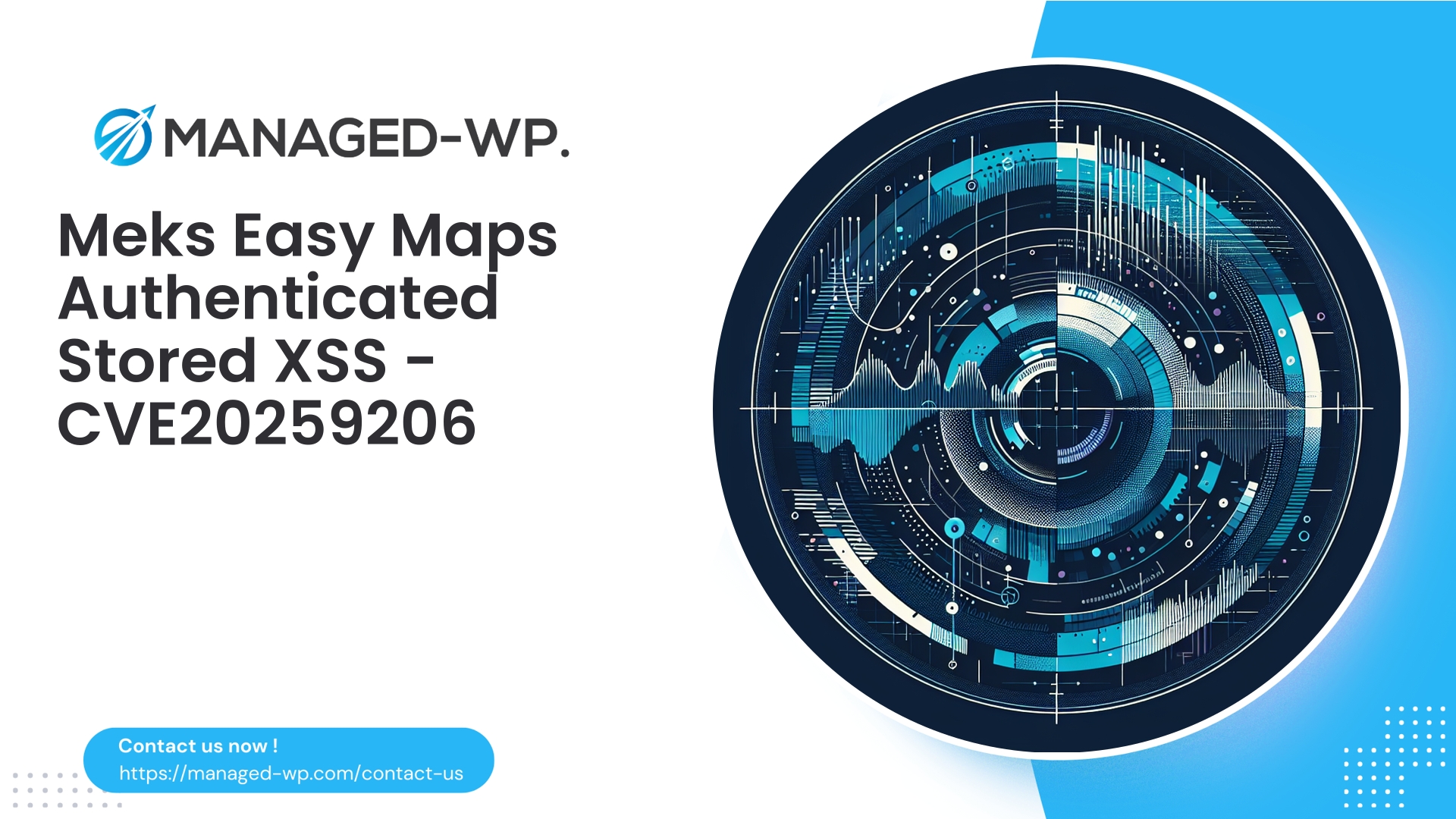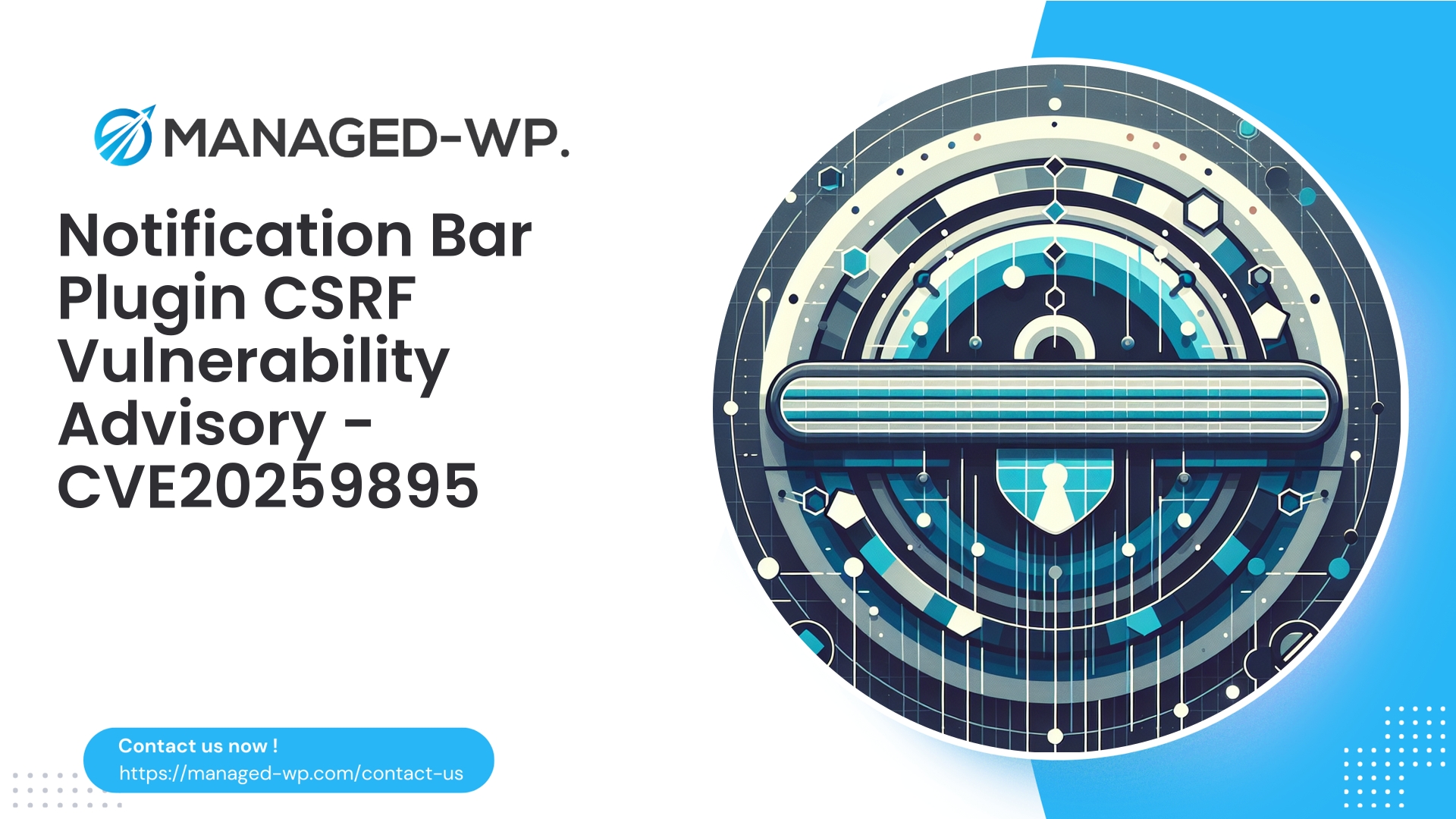| 插件名稱 | Meks簡易地圖 |
|---|---|
| 漏洞類型 | 儲存型XSS |
| CVE編號 | CVE-2025-9206 |
| 緊急 | 低的 |
| CVE 發布日期 | 2025-10-03 |
| 來源網址 | CVE-2025-9206 |
Meks Easy Maps <= 2.1.4 — 已認證(貢獻者及以上)儲存型 XSS 漏洞 (CVE-2025-9206):風險、偵測、緩解措施以及 Managed-WP 如何保護您的網站
Managed-WP 的美國安全專家撰寫了這份全面專業的指南,深入剖析了 Meks Easy Maps(版本 <= 2.1.4)中的已認證儲存型跨站腳本漏洞。指南涵蓋了風險、實際影響、檢測技術、安全修復方法、開發者最佳實踐,以及我們的託管式 WAF 和虛擬修補程式解決方案如何立即保護您的 WordPress 網站。
由 Managed-WP 安全團隊
執行摘要
2025年10月3日,影響WordPress Meks Easy Maps插件(版本2.1.4及以下)的儲存型跨站腳本(XSS)漏洞被公開揭露,漏洞編號為CVE-2025-9206。該漏洞允許具有貢獻者等級或更高存取權限的已認證使用者註入惡意JavaScript有效載荷,這些有效載荷會在其他使用者的瀏覽器中持久存在並執行。
儘管該漏洞需要經過驗證的攻擊者才能利用,但其後果可能十分嚴重:持久性 XSS 漏洞可導致權限提升、管理員會話中的未經授權操作、網路釣魚、惡意軟體傳播以及其他惡意活動。官方 CVSS 評級為 6.5,屬於中低嚴重性級別,但風險仍相當高。由於披露時尚未發布官方補丁,網站管理員必須依靠其他安全措施來保護其環境。
本文概述了該漏洞的機制、可能的利用場景、檢測策略、緩解建議、安全修復的開發人員指南,以及 Managed-WP 的虛擬修補程式和託管 WAF 服務如何立即保護您的網站。
快速風險概覽
- 漏洞類型: 儲存型跨站腳本攻擊(XSS)
- 受影響的軟體: Meks Easy Maps WordPress 插件
- 受影響版本: 2.1.4 及更早版本
- CVE標識符: CVE-2025-9206
- 所需權限: 認證貢獻者或更高級別
- 公開揭露日期: 2025年10月3日
- 補丁狀態: 截至披露時,尚無官方解決方案。
- CVSS評分: 6.5(中/低,視環境而定)
- 主要風險: 攻擊者提供的 JavaScript 程式碼會在管理員或訪客瀏覽器中持續執行
了解儲存型 XSS 及其對 WordPress 的影響
儲存型 XSS 漏洞是指應用程式接收使用者輸入、持久儲存該輸入,然後在未進行適當的清理或轉義處理的情況下將其輸出。在 WordPress 環境中,儲存型 XSS 漏洞尤其危險,因為:
- 一個用戶的內容可能會影響其他用戶,包括網站管理員。
- 在管理員瀏覽器上下文中執行腳本可能導致透過偽造請求進行未經授權的管理操作。
- 具有多個使用者角色的網站會增加攻擊面,因為惡意攻擊者可以針對具有較高權限的使用者發動攻擊。
當外掛程式處理地圖特定輸入(標記名稱、描述、嵌入式 HTML 或短程式碼屬性)並在未進行清理的情況下儲存資料時,這會建立一個持久的攻擊向量,能夠注入不安全的 JavaScript 程式碼。
進階漏洞機制
根據先前在 WordPress 外掛程式中發現的漏洞揭露和模式,該漏洞的運作方式如下:
- 經過身份驗證的貢獻者及以上層級可以透過外掛程式介面建立或編輯地圖條目(標記、標籤、描述、區域)。
- 該插件將這些輸入(例如選項、文章元資料或自訂表)直接儲存到資料庫中,而沒有進行充分的清理。
- 當這些儲存的值隨後輸出到前端或管理頁面時,它們沒有經過適當的轉義處理,而是直接嵌入到 HTML 上下文中。
- 嵌入在這些輸入中的惡意腳本會在檢視頁面的使用者情境中執行,導致儲存型跨站腳本攻擊。
筆記: 為避免暴露更多攻擊途徑,本安全公告刻意不提供概念驗證程式碼或具體有效載荷。重點在於檢測和安全緩解措施。
潛在攻擊場景
- 管理員會話劫持: 受感染的貢獻者註入惡意程式碼,竊取管理員的 cookie 或會話令牌。
- 大規模重定向或惡意軟體注入: 訪客會被重新導向到惡意網站或感染惡意下載程式。
- 網路釣魚攻擊: 頁面被竄改,以顯示虛假的登入提示或資料收集表單。
- 持久後門: 嵌入插件資料中的惡意腳本可授予持續的存取權限或控制權。
- 品牌損害和搜尋引擎優化懲罰: 惡意內容會降低網站信譽,並可能被列入黑名單。
筆記: 利用此漏洞需要貢獻者層級的存取權限,因此限制貢獻者註冊可以顯著降低風險。
如何偵測您的網站是否有漏洞
- 確認是否已安裝 Meks Easy Maps 並檢查版本:
- 透過 WordPress 控制面板 → 插件,或運行
wp 插件狀態 meks-easy-maps透過 WP-CLI。
- 透過 WordPress 控制面板 → 插件,或運行
- 識別使用地圖或包含短代碼的面向公眾的頁面;這些區域可能會執行惡意腳本。
- 掃描可疑儲存內容:
- 使用安全工具或惡意軟體掃描器尋找嵌入式惡意軟體。 tags or suspicious event handlers.
- 在資料庫中搜尋相關外掛程式欄位(標記描述、地圖元資料)中的原始腳本標籤。
- 查看貢獻者活動,了解近期是否有異常的編輯或新增。
- 在隔離環境中執行前端檢查;注意意外重定向或錯誤日誌。
- 檢查伺服器和應用程式日誌,尋找異常或可疑的插件相關 POST 請求。
偵測需要保持警覺-注意在預期為純文字的區域中是否存在意外的內聯腳本或 HTML。
逐步實施的即時緩解建議
如果您的網站使用 Meks Easy Maps 且目前尚無補丁可用,請優先執行以下操作:
- 立即備份您的網站(文件和資料庫),以保存證據並實現復原。
- 如果地圖功能並非業務關鍵功能,請考慮暫時停用該外掛程式。
- 如果地圖必不可少,則應限制其使用:
- 暫時從公共頁面移除地圖短代碼。
- 地圖頁面僅限已認證使用者檢視。
- 限製或暫停投稿者帳號,直到核實內容乾淨為止。
- 匯出暫存資料庫副本,搜尋並隔離可疑的儲存資料(腳本標籤、事件屬性)。
- 將插件儲存的輸入進行清理,移除不安全程式碼,同時盡可能保留合法文字。
- 輪換管理員和貢獻者密碼以及任何相關的 API 金鑰。
- 使用 Managed-WP 內建的掃描工具或替代方案,執行完整的惡意軟體掃描。
- 至少連續幾天仔細監控日誌和流量,以發現異常活動。
如果懷疑系統遭到入侵,請立即聯絡事件回應專家。
Managed-WP 如何保護您的 WordPress 網站
Managed-WP 提供多層防禦措施,在補丁程式等待期間保護您的網站:
- 託管式 Web 應用程式防火牆 (WAF): 我們部署有針對性的虛擬補丁,以阻止關鍵攻擊途徑,包括針對腳本注入模式的請求過濾。
- 惡意軟體掃描與監控: 持續掃描注入腳本和可疑內容。
- 角色和行為異常檢測: 對貢獻者使用者的異常行為發出警報。
- 虛擬補丁: 暫時、精確的 HTTP 攔截,防止漏洞利用,無需修改外掛程式碼。
- 存取控制: 速率限制和 IP 信譽保護可以減少自動化或暴力破解嘗試。
啟用 Managed-WP 的免費基礎版,網站擁有者即可立即獲得此類漏洞的自動保護。
概念性虛擬緩解策略
- 封鎖包含可疑程式碼片段的 POST 要求,例如: tags, “onclick=”, “onerror=”, or “javascript:” URIs in fields expected to be plaintext.
- 將與地圖欄位相關的傳出內容中的不安全 HTML 標籤和屬性進行清理或刪除。
- 自動隔離或標記觸發啟發式檢查以發現可疑內容的新地圖條目。
- 發布前,對投稿者提交的地圖內容實施更嚴格的審批流程。
這些緩解措施應用於由 Managed-WP 安全營運部門管理的 WAF 和內容過濾層。
開發者關於插件安全改進的建議
- 儲存時對所有輸入內容進行清理:
- 槓桿作用
sanitize_text_field()用於純文字。 - 當需要使用 HTML 時,請嚴格遵守相關規定。
wp_kses()白名單。 - 絕不儲存低信任度使用者的未經過濾的 HTML 內容。
- 槓桿作用
- 轉義所有輸出:
- 使用合適的功能,例如
esc_html(),esc_attr(), 或者esc_js()視情況而定。 - 使用以下方式安全地編碼 JSON 輸出
wp_json_encode()結合逃脫。
- 使用合適的功能,例如
- 驗證能力和隨機數:
- 透過以下方式檢查使用者權限
當前使用者可以(). - 使用
wp_verify_nonce()對抗 CSRF 攻擊。
- 透過以下方式檢查使用者權限
- 避免直接以內聯方式渲染使用者輸入的原始資料而不進行轉義。
- 在 REST 端點上實作參數驗證和清理。
- 強制執行輸入長度和字元限制,以限制攻擊途徑。
- 使用預編譯語句進行資料庫互動。
- 記錄變更並考慮對不受信任的角色採用審核工作流程。
遵循這些準則將有助於防止 Meks Easy Maps 或類似插件中出現儲存型 XSS 和其他注入風險。
惡意儲存內容的安全性清理程序
- 最初在測試環境中工作,絕不直接在生產環境中工作。
- 確定插件資料儲存位置(例如,
wp_posts,wp_postmeta(自訂表格)。 - 搜尋並隔離可疑內容-仔細記錄受影響的記錄。
- 使用以下方法清理或移除危險的 HTML/腳本元素
wp_kses()制定了嚴格的規則。 - 測試地圖渲染,確保功能完好無損且沒有腳本殘留。
- 在維護窗口期間,謹慎地在生產環境中應用清理變更。
- 進行清理後惡意軟體掃描並查看管理員活動日誌。
如有疑問,請諮詢安全專家,以免損壞合法內容或遺漏持久性後門。
事件回應檢查表
- 遏制: 暫時停用存在漏洞的插件,並暫停可疑的貢獻者帳號。
- 保存: 建立所有網站資料和日誌的取證備份。
- 調查: 查看存取日誌和錯誤日誌,掃描是否有 Web Shell 或未經授權的管理員使用者。
- 補救措施: 刪除惡意內容,清理受感染文件,輪換所有憑證和 API 金鑰。
- 恢復: 在重新上線之前,先在測試環境中恢復乾淨的網站快照,並實施監控。
- 通知: 如果懷疑個人資料洩露,應通知所有受影響的利害關係人。
降低未來風險的最佳實踐
- 最小特權原則: 限制貢獻者權限,避免不必要的HTML或檔案上傳權限。
- 用戶註冊受控: 實施電子郵件驗證、人工審核或管理員審核。
- 內容安全策略(CSP): 應用嚴格的 CSP 標頭來降低注入腳本帶來的風險。
- HTTP 安全標頭: 強制執行現代安全標頭,例如
X-Content-Type-Options,X-Frame-Options, 和嚴格的運輸安全. - 定期掃描和監測: 安排惡意軟體掃描和WAF規則更新。
- 穩健的備份策略: 定期進行備份並驗證復原過程。
- 保持插件和核心程式更新: 在官方修復程式延遲發布的情況下,使用虛擬補丁。
- 日誌記錄和警報: 長期保留日誌,並對可疑的管理員或貢獻者活動設定警報。
立即保護您的 WordPress 網站 — 免費試用 Managed-WP
為了立即加強防禦此類漏洞,請考慮註冊 Managed-WP 的免費基礎套餐。該套餐包含託管防火牆、WAF 防護、惡意軟體掃描以及針對 OWASP Top 10 威脅的緩解措施——所有這些都旨在降低您在官方插件更新期間的風險。了解更多並在此處註冊: https://my.managed-wp.com/signup/free
安全團隊監控指南和偵測規則
管理員可以透過關注以下方面來改善監控:
- 包含可疑字串的新增或更新的插件記錄(“
- 地圖條目或標記數量意外激增。
- 由貢獻者發起的 POST 請求,其有效負載長度或字元數異常。
- 管理員登入後立即出現頁面加載,導致重定向或控制台錯誤。
- 貢獻者操作後,管理員使用者意外建立或角色發生變更。
盡可能根據這些指標自動發出警報並啟用臨時封鎖或審核功能。
在等待官方插件更新期間,您應該注意什麼?
- 供應商的回應時間各不相同;攻擊者可能會試圖在此期間利用公開披露的資訊進行攻擊。
- 透過託管防火牆進行虛擬修補,可以過濾惡意請求和不安全的儲存內容,從而最大限度地減少風險。
- 繼續實施加固措施和監控,一旦安全版本可用,立即更新插件。
貢獻者等級漏洞的重要性
儘管貢獻者權限低於管理員,但這一級別的漏洞仍然會帶來真正的安全風險,因為:
- 入侵或社會工程攻擊可以提升攻擊者的存取權限。
- 惡意腳本在管理員瀏覽器中執行,從而實現權限提升。
- 擁有多個貢獻者或客座作者的網站會增加攻擊面。
解決貢獻者風險對於建立強大的 WordPress 安全態勢至關重要。
最終行動清單
- 請確認您的網站上是否已安裝 Meks Easy Maps (≤ 2.1.4)。
- 如果已發生,請立即採取緩解措施:
- 暫時停用插件或
- 啟動 Managed-WP 的安全防護(免費層級包括 WAF + 惡意軟體掃描)。
- 使用測試環境安全地掃描和搜尋可疑的儲存內容。
- 加強對貢獻者權限和使用者註冊流程的監管。
- 備份所有資料並保存取證證據。
- 密切監控日誌和安全警報。
- 一旦官方插件發布補丁,請立即安裝更新。
Managed-WP 安全專家的閉幕致辭
安全依賴多層防禦。 Meks Easy Maps 儲存型 XSS 漏洞揭露凸顯了插件開發者和網站所有者採用安全輸入/輸出處理和權限控制的緊迫性。
網站管理員應優先考慮快速偵測、立即緩解和持久修復:清理輸入、轉義輸出、限制權限,並維護強大的備份和監控。
Managed-WP 的免費基礎方案提供了良好的基礎,在供應商尚未發布官方修補程式期間,提供必要的防火牆保護、惡意軟體掃描和針對 WordPress 主要風險的緩解措施。
網站安全取決於快速有效的防護措施與長期的解決方案相結合。保持警惕,做好防護。



















